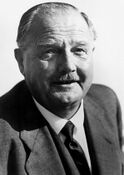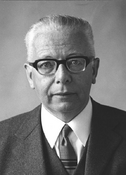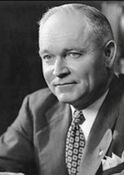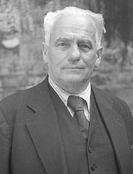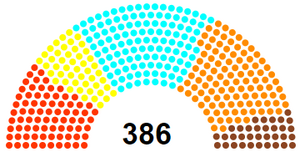1966 West Besmenian parliamentary election: Difference between revisions
Neuleinster (talk | contribs) |
Neuleinster (talk | contribs) |
||
| Line 288: | Line 288: | ||
==Results== | ==Results== | ||
{| class=wikitable style=text-align:right | {| class=wikitable style=text-align:right | ||
|colspan=5|[[File:WBP | |colspan=5|[[File:WBP 1966new.png|center|300px]] | ||
|- | |- | ||
!colspan=2 rowspan="2" style="width:60px;"|Party | !colspan=2 rowspan="2" style="width:60px;"|Party | ||
Revision as of 13:29, 11 July 2021
| |||||||||||||||||||||||||||||||||||||||||||||||||||||||||||||
| |||||||||||||||||||||||||||||||||||||||||||||||||||||||||||||
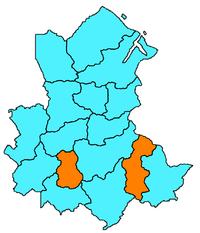 Results by district for the votes. | |||||||||||||||||||||||||||||||||||||||||||||||||||||||||||||
| |||||||||||||||||||||||||||||||||||||||||||||||||||||||||||||
The 1966 West Besmenian legislative election was held on October 16, 1966 in the Besmenian Republic. It was the first free election in West Besmenia since 1921.
Background
After the West Besmenian Revolution and the victory of the revolutionaries, the democratization of West Besmenia began on June 9, 1966 after Rudolf Bötte (successor to Lars Schreim) proclaimed the Besmenian Republic and appointed himself president. After many political parties were founded in June 1966 after the 1922 prohibition of parties was repealed, Bötte announced free elections for October 16th. On July 16, Bötte resigned as president. Hermann Himmerlich became his successor.
Election campaign and election programs
The election campaign for the election was short and presented the parties with major organizational challenges, because these were only recently founded. In many places civil rights activists had enforced that offices were made available to them. Both the new groups and the parties experience in election campaigns. This gap was closed by massive engagement of the East Besmenian parties. All parties in East Besmenia supported their partner parties in West Besmenia to a large extent and were thus able to more than make up for the organizational lead of the BNU. Many East Besmenian politicans, like Jürgen Rothmann or Helmut Glaubrecht, took vacation to support their partner party in the West Besmenian election campaign.
Contesting parties
List of the largest parties
| Name | Ideology | Party leader | President candidate | ||
|---|---|---|---|---|---|
| DB | Democratic Besmenia Demokratisches Besmenien |
Liberal conservatism Besmenian unionism |
Horst Lommberg | Horst Lommberg | |
| KUB | Conservative Union of Besmenia Konservative Union Besmeniens |
Conservatism Christian democracy |
Robert Baalke | Robert Baalke | |
| BSP | Besmenian Socialist Party Besmenische Sozialistische Partei |
Social democracy Democratic Socialism |
Erich Bölker | Erich Bölker | |
| LPB | Liberal Party of Besmenia Liberale Partei Besmeniens |
Liberalism Social liberalism |
Günther Meier | Günther Meier | |
| BNU | Besmenian National Union Besmenische Nationalunion |
National conservatism Ochsenbeinism |
Rudolf Bötte | Hermann Himmerlich | |
Results
| Party | Votes | % | Seats | |
|---|---|---|---|---|
| Democratic Besmenia | 9,164,157 | 30,9 | 122 | |
| Conservative Union of Besmenia | 7,829,571 | 26.4 | 105 | |
| Besmenian Socialist Party | 5,753,548 | 19,4 | 77 | |
| Liberal Party of Besmenia | 3,558,896 | 12 | 48 | |
| Besmenian National Union | 2,580,199 | 8,7 | 34 | |
| Other parties | 711,779 | 2,4 | 0 | |
| Invalid/blank votes | 59,314 | 0,2 | – | |
| Total | 29,657,464 | 100 | 386 | |
| Registered voters/turnout | 32,676,111 | 90,7 | – | |
Aftermatch
After the election, the two largest parties DB and KUB agreed on a joint coalition with Horst Lommberg as President and Robert Baalke as Vice President. The DB-KUB government started its work on November 8, 1966.
